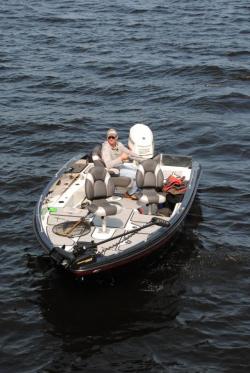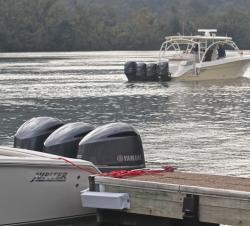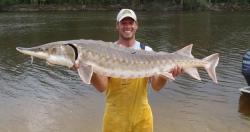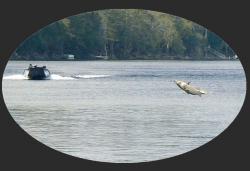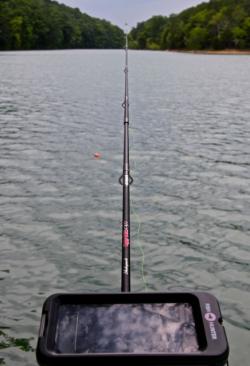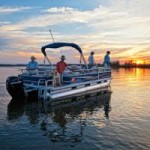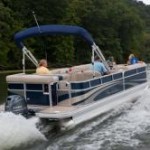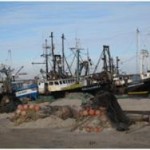Kayaking Basics from Florida’s FWCC
from The Fishing Wire

Fishing from a kayak
Thinking of buying yourself a ‘yak for Christmas? Here are some of the points you might consider.
Last year my wife and I finally got a pair of kayaks. I’d had a chance to paddle a friend’s kayak once or twice before, but never had a kayak of my own to spend some serious time with. Even after a couple decades of small-craft boating, I was quite impressed with the portability and versatility of these craft. Here’s some of what I’ve learned in the past year.
Cost: If you’ve been thinking of taking the plunge with a kayak, there’s never been a better time. Kayaks have become very popular in recent years, meaning that more manufacturers are making them and prices for an entry-level kayak are even lower than they used to be. Standard kayak models start at a low of about $200 on sale, but you’ll want to spend more for a fishing kayak that comes complete with rod holders and other angling amenities-expect to pay from $250 on up on sale. You’ll also be buying a double-bladed kayak paddle, which will run you $50-100 or more. Most kayaks don’t include a padded seat, and you’ll probably want one; add another $50-75. Yes, the tab is adding up pretty quickly, but you’re still well under what the cheapest johnboat and trolling motor will cost you. Smaller accessories, such as a light anchor and-of course!-a life vest, you may own if you’re already a boater.
A kayak is a very personal purchase, and you should buy from a vendor that will allow an exchange if you don’t like the way the craft fits you or how it performs in the water. Otherwise, some kayak shops are near water and will let you try before you buy. Keep in mind that you’ll need a way to transport your kayak, if you can’t just throw your new purchase in the pickup and head for the lake. A good roof rack setup or trailer will cost you more than your kayak will, but a kayak is still one of the most economical boating options out there. (See Issue 45 at www.bit.ly/FFAngler for more information about roof racks.)
Sit-on-top versus sit-inside: There are two basic kayak types. A sit-on-top kayak is a sealed hollow shell with molded seating on top to accommodate the paddler. It’s easy to get in or out of, a major plus if you plan to kayak-and-wade. The kayaker sits above the waterline, which increases visibility and casting distance, but leaves the kayaker exposed to waves and splashing. Storage space is mostly open to the elements, but is easily accessible. However, there will probably also be one or two watertight hatches that allow dry storage inside the kayak shell. Note the size and location of the hatch openings, as these will limit what you’ll be able to fit inside and whether you’ll be able to reach them from the kayak seat. Water that splashes into the kayak drains out through scupper holes, which can be plugged to prevent water ingress, if you’ll be on calm water.
A sit-inside kayak is self-descriptive: the paddler sits inside a cutout in the open hull. Add an apron, and the paddler is pretty well protected below the waist from waves and water. The angler is sitting at the waterline, and the lower center of gravity may provide a more stable ride but slightly limited visibility and casting distance. The open hull provides plenty of fairly dry inside storage in front of and behind the kayaker. However, this internal storage is not as easily accessible, and entering and exiting the kayak is not nearly as easy. Generally, the sit-inside design is a good choice for river or ocean kayaking but will also serve in quieter ponds and lakes. However, many stillwater anglers prefer the in-and-out convenience offered by the sit-on-top design.
Fishing kayaks: The simplest thing that defines a “fishing kayak” is the presence of rod holders. A fishing kayak will also usually be wider than standard kayaks-around 30″ or so-and therefore more stable. It may have extra storage features, like molded in tackle trays or even a baitwell. Note that you can add after-market rod holders to most kayaks, but you’re better off starting with a fishing kayak, mainly for the added stability. A wider kayak won’t cut through the water as quickly as a standard model, but you’ll be able to cast, set the hook, and land frisky fish without feeling like you’re about to take a spill at any moment. I was really surprised at how stable my kayak is-definitely less tippy than most canoes I’ve used.
Length: Length is important. A longer kayak will travel faster and more efficiently (and have more storage space), but weigh more to load and carry-especially important if you’re cartopping or portaging. Twelve to thirteen feet is a popular range for saltwater anglers, and will provide a roomy and stable freshwater fishing platform too. However, if portability is important, look hard at kayaks ten feet or less in length. My ten-footer is a lightweight at exactly fifty pounds, but I’d still swear it’s half full of water when I hoist it back onto my roof racks at the end of a long paddling day. The weight is much easier to handle if you’re securing your craft to something below shoulder level, like a pickup bed or trailer. A kayak cart can also be a big help moving your boat from car to water (more on that later). Long story short, consider weight an important factor based on how you’re transporting your kayak.
Paddles: Kayak paddles are double bladed, unlike rowboat oars or canoe paddles. This makes the kayak an extremely efficient craft, because you propel it with both the forward and what otherwise would be the “back” stroke. Paddles come in specific shaft lengths, which you choose based on the width of your kayak and your height. The wider your kayak and the taller you are, the longer paddle shaft you will need. Kayak and paddle manufacturers provide tables for making your best choice. Paddle blades also vary. A long narrow blade works well for propelling a kayak nonstop over long distances, while a short broad blade works well for tight maneuvering along brushy shorelines and the stop-and-go travel a kayak angler will likely be making. In Florida’s lakes and ponds, most anglers should stick with a broad blade. As a side note, be aware that some fishing kayaks are equipped with various ingenious pedal-and-propellor systems that make propulsion a lot easier and leave your hands free for fishing. These are nice, but significantly more expensive, and are generally restricted to longer kayaks. Some kayaks can be outfitted with a trolling motor; note that you will have to register the kayak if you go this route, and will need room for a 12-volt battery.
Accessories: Your number one accessory is your life vest, or PFD (personal flotation device). I prefer an inflatable PFD for its coolness and light weight, although many kayakers will tell you that you’re going to tip over (and activate the CO2 cylinder) sooner or later. Your risk is less in stillwater ponds and lakes; however, I’m willing to live with that possibility, especially during the summer heat. Make sure you are also complying with all other boating safety requirements (MyFWC.com/boating/safety-education). Another “must have” accessory will be a dry storage bag for keeping your phone, electronic car keys, camera and other sensitive gear safe from the elements.
If you are going to have to carry your kayak any distance between your parking spot and the water, consider buying a wheeled kayak carrier. These handy little carts strap onto the bottom of your kayak, allowing you to roll your craft to the water. An advantage of these is that you can load all your equipment into the kayak as well and make a single quick trip, rather than going back and forth to your vehicle for paddle, anchor, rods, etc. or having to try to carry them all at once. Strapping the wheels in place near the kayak’s center of gravity will provide a balanced and effortless walk to the water’s edge. Some kayak manufacturers offer carts that will fit right into their kayaks’ scupper holes, eliminating the need for straps.
One of the (few) annoying things about fishing from a lightweight kayak is that it is easily pushed around by wind or waves, so you’ll want a lightweight folding anchor to help you stay put. An anchor works best in deeper water or when you’ll be staying put for a little while, such as when fishing bait. If you use the anchor a lot, you’ll want an anchor trolley that allows you to position the anchor line fore or aft, depending on wind or current and how you want to position your craft. For frequent moving and anchoring-which I’ve found to be the norm for lure fishing-a stakeout pole is much more convenient. This is simply a pole pushed into the lake bottom to anchor the kayak. The pole can be inserted through a scupper hole, or attached to the kayak with a short rope and snap clip. Many anglers prefer a stakeout pole over an anchor, because there’s less chance of tangling with a scrappy fish. You can buy a commercial stakeout pole, or make your own out of PVC pipe or any other sturdy pole such as an old golf club with the head removed. Use is obviously limited to fairly shallow water, depending on the length of the stakeout pole.
There’s a host of other accessories available: extra or specialized rod holders, rod and paddle tethers, depth finder and camera mounts, special kayak tackle holders, baitwells, and more. Kayakers (and kayak manufacturers) seem to be a particularly inventive lot! Customizing your kayak for your comfort and specific fishing needs can not only put more fish in the boat, but also be a satisfying end in itself.
Care and feeding: One of the great things about kayaks (especially if you’ve ever scrubbed down a large boat after a saltwater fishing trip) is that they require almost no maintenance. Just hose your kayak off after a muddy or saltwater fishing trip, stow it out of direct sunlight, and that’s about it! With minimal care, a kayak will last for years.
Fishing from a kayak: Okay-you already know how to fish. But fishing from a kayak is different, even from fishing in a small canoe or johnboat. While fishing kayaks are usually very stable, you must keep your balance in mind at all times-when leaning over to unhook a snagged lure, setting the hook or netting a fish. While fishing kayaks are roomier than their standard-sized brethren, space is still at a premium. Many of your kayak customizations, if you make any, will probably involve gear storage. I don’t like much in my way while kayak fishing, and keep minimal gear (like hooks, plastic worms, and pliers) in a small tackle box or tackle bag in front of me. The rest of my tackle, plus raingear, sunblock, etc. are in a larger waterproof duffle bag stowed behind my seat. I don’t need to move to release a fish, tie on a new hook, or change out my worm. If I need something more, I can reach back to grab the duffel bag, or hop out in shallow water to grab it. Water or sports drinks-a must for the Florida kayaker-go under the bungee straps in the front or rear of my kayak, depending on the rest of my loadout and available space. My kayak actually has a cup holder right in front of the seat, and a sports drink goes there right away when I launch.
I’ll work a shoreline or deeper water the way I normally would from any small boat. However, since I’m sitting low my casting distance and visibility are more limited, so I sometimes have to work closer. Thankfully, a stealthy kayak is ideal for this. I can often paddle along just casting as I go, but sometimes wind or wave action requires me to anchor my stakeout pole at every stop. A stakeout pole or anchor also help when you hook a bigger fish. You’ll be able to land most fish with ease, but I’ve had hard-fighting fish as small as four pounds take me for a brisk “sleigh ride”. This can actually be fun in open water, but if you’re casting anywhere near docks or submerged brush you’ll want to anchor yourself if you hope to have any control when “the big one” hits. And when he does, a kayak will put you closer to the action than anything else except wading.
The kayak advantage: Besides simply being fun and exciting to fish from, kayaks have one more major advantage: portability. Anywhere you can stand, you can launch. Since getting my kayak, I’ve been amazed at the world of new fishing opportunities that have opened up for me. Some of these new opportunities have turned up at my “old” fishing holes, where I can now launch a boat off a 60-degree canal bank, or where a sliver of public shoreline lets me get into an otherwise-inaccessible lake. I recently fished a narrow canal that would have been too brushy even for a canoe. There’s something eminently satisfying about catching a big fish that you know was out of reach of anyone else-except a fellow kayaker.
For more information: Numerous books specifically on kayak fishing are now available. Online, general information about getting started in kayaking can be found at smart-start-kayaking.com. Numerous videos on everything from getting in and out of your kayak without tipping over to paddling and fishing from it can be found by searching at YouTube.com.
